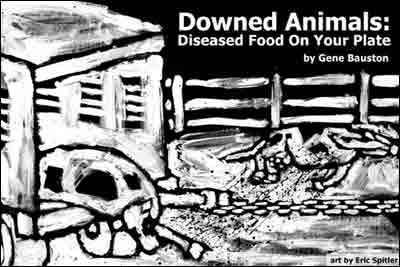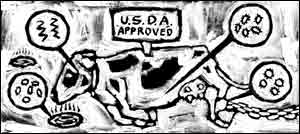IMPACT
press
Downed Animals: Diseased Food On Your Plate
E-Mail Us
Your Comments
|

by Gene Bauston
art/Eric Spitler
A sick cow, too weak to stand, is pulled off of a truck by a tractor and chain, then falls four feet to the ground at a stockyard. A frail, day old calf is dragged through an auction ring by a back leg, while another calf, nearly comatose, is left in a corner to die. These are not isolated incidents. Across the United States, downed animals, animals too sick or weak to even stand, are being marketed and slaughtered for human food. They suffer horribly at stockyards and slaughterhouses, and their use in the human food chain poses a threat to human health.
It is practically impossible to handle and transport downed animals humanely. Even industry groups, including Central Livestock and Empire Livestock, admit, "...it is near impossible to unload and/or move downed animals in a humane manner without first euthanizing them." Downed animals are commonly moved by the most convenient, though least humane methods. They are dragged with wenches and chains or pushed with tractors and forklifts, procedures which cause injuries ranging from bruises and abrasions to broken bones and torn ligaments. When former United States Department of Agriculture (USDA) Secretary Edward Madigan saw videotape showing downed animals being moved by these methods, he said he was "disgusted and repelled." Incapable of getting to food or water troughs, downed animals endure hours or days without receiving these basic needs. In addition, they are denied necessary veterinary attention, and many die of gross neglect.
Most downed animals are victims of the dairy industry -- either worn out milk cows or fragile baby calves. Too often, dairy farmers ship dying animals to the stockyard in order to avoid the cost of disposing of dead animals on the farm. In response to nationwide news coverage criticizing industry's irresponsible mistreatment of downed animals, Hoards Dairyman wrote, "The black eye the livestock industry got over the widespread 'downer cow' publicity was self-inflicted. Frankly, we got what we deserved... Because of that unfortunate exposure, the image of livestock people has been tarnished, and consumers have yet another reason not to eat meat... There's no excuse for shipping animals which cannot walk." In addition to downed dairy cattle, incapacitated pigs, sheep, goats, and horses are also sold for slaughter. Responding to media pressure, Pork Report warned, "Producers should not 'push their problems' on trucks and hope to receive some salvage value for the animal or use the stockyards as a disposal system for this type of animal."
Marketing and slaughtering downed animals for food poses a serious threat to consumers. An article from Meat and Poultry magazine cited university research and reported, "...lame cattle usually have higher levels of bacteria on their carcasses. Lame animals spend more time lying down, which increases the likelihood they will be contaminated with fecal matter." Of course, downed animals spend all of their time on the ground. In addition to an increased risk of bacterial contamination, there is scientific evidence which indicates that some downed cattle in the United States may be afflicted with a variant of "Mad Cow Disease" (BSE or Bovine Spongiform Encephalopathy). When the population of a Wisconsin mink ranch was decimated by an outbreak of transmissible mink encephalopathy, scientists hypothesized that the disease was caused by the minkšs diet -- a diet comprised primarily of downed dairy cows. After researching the incident, published findings "suggest[ed] the presence of an unrecognized BSE-like disease in the United States."
Attempting to address the downed animal problem and to allay public concerns, many stockyards and slaughterhouses have stopped accepting downed animals. This 'no downer' approach has caused farmers and livestock handlers to take steps to prevent downed animals in the first place. Commenting on this, dairy veterinarian Lester Friedlander stated, "This winter the slaughterhouses in this area stopped accepting downed cows... I have been very impressed with the response my [dairy] clients have shown since they have not been able to sell downed cows. I have been called to attend more of the downed cows to provide veterinary assistance and to humanely euthanize the hopeless cases... In short, not selling cows as downers has not hurt my clients but has re-focused attention in the right direction -- prevention and rehabilitation."

There is a growing consensus, even among industry representatives, that downed animals should not be marketed or slaughtered for human food as an article from Beef Today, entitled "Zero Tolerance for Downer Cows," indicates. The article begins, "A downer cow in the sale barn aisle is not a pretty sight. For starters, it's a sure bet that everyone involved, including the cow, loses. To compound the problem, it is highly visible fuel for animal rights organizations." After providing examples of stockyards that have implemented 'no downer' policies, whereby they do not market downed animals, the article ends with a quote from a Colorado beef specialist, "A downer animal is a violation of our responsibility as stewards of livestock. We need to prevent these situations for a lot of reasons -- the most important being, it's the right thing to do."
Unfortunately, while some within the livestock industry have acted responsibly, others continue to market downed animals, sometimes in violation of their own stated "no downer" policies. The USDA surveyed stockyards across the U.S. and found the livestock industry's self-policing to be flawed. In documents obtained through the Freedom of Information Act, the USDA reported, "Though many market representatives responded without hesitation that they would turn downers away from their doors, it became evident that some stockyards did not have a firm 'no downer' policy in place and would make exceptions..."
Also of concern, the U. S. Department of Agriculture and the U.S. Food and Drug Administration have failed to grant a petition filed by Farm Sanctuary to prohibit the slaughter of downed animals for human food. Citing federal laws, the petition argues that downed animals are "diseased" by definition, and therefore asserts that these animals cannot be used for human food. Responding to this, the USDA shockingly asserted that the law did not prohibit diseased animals from being used for human food. (Letters are currently needed to urge that this petition be granted. Please see sidebar below for details.)
Although thousands of downed animals are slaughtered across America every year, these animals represent a very small percentage of all livestock slaughtered. No farmer depends on the sale of downed animals for a livelihood. In addition, the vast majority of downed animals sent to stockyards and slaughterhouses could be prevented with basic management and handling improvements on the farm and in transportation. According to an article in Meat & Poultry magazine, "Ninety percent of all downers are preventable... the industry can eliminate downers by euthanizing them."
Although the livestock industry has been aware of downed animal suffering for decades, this problem has not been corrected through voluntary measures. Unscrupulous downed animal dealers and slaughterhouse operators are circumventing others' "no downer" policies, exploiting a niche market, and undercutting voluntary efforts to resolve this problem through preventative measures. It is increasingly clear that this problem will continue in the absence of government action.
In addition to the petition urging a prohibition on downed animal slaughter that is currently before the FDA, the Downed Animal Protection Act has been introduced in both the U.S. House of Representatives and the U.S. Senate. While the petition seeks a prohibition on the slaughter of downed animals for human food, the Downed Animal Protection Act requires the humane euthanasia of downed animals in the marketing channels. With this issue at the slaughterhouse, the legislative proposal addresses it in marketing channels (i.e. at auctions and in transit). Both the petition and the legislative effort ultimately seek to remove the market for downed animals, and thereby provide a strong and clear incentive for farmers and livestock handlers to focus on providing better care and preventing downed animals in the first place. •
Gene Bauston is the co-founder of Farm Sanctuary. He holds a degree in agricultural economics from Cornell University.
Make an IMPACT
"NO DOWNERS" ACTION ALERT
Last year, the USDA announced a landmark policy to stop purchasing meat from downed cows for federal programs, including the National School Lunch Program. The Agency stated, "USDA will no longer accept ground beef that includes product from non-ambulatory cattle, commonly known as 'downers.'" This development shows a growing consensus -- even among livestock industry and government officials -- that the marketing and slaughter of downed animals is unacceptable.
Our chances of stopping the downed animal trade are better now than ever, and letters are needed to urge the Food and Drug Administration to grant petition 98P-0151/CP1 to prohibit the slaughter of downed animals. Please write today, and please encourage others to write as well:
U.S. Food and Drug Administration
Dockets Management Branch
5630 Fishers Lane, Room 1061
Rockville, MD 20852
FAX: 301-827-6870
E-mail: FDADockets@oc.fda.gov
PLEASE NOTE: IT IS CRITICAL TO REFER TO DOCKET NUMBER 98P-0151/CP1 IN YOUR LETTER.
Here are some points you may wish to include:
- Animals who are too sick or injured even to stand should not be allowed to enter the human food chain.
- * In addition to posing an increased risk for bacterial contamination, there is evidence that some downed animals may be afflicted with a form of BSE (Bovine Spongiform Encephalopathy or "Mad Cow Disease"), a disease which has been linked to the fatal human illness, CJD (or Creutzfeldt-Jakob Disease).
- It is impossible to move downed animals humanely, and they are typically pushed with tractors or dragged with chains -- inhumane processes which cause injuries ranging from bruises and abrasions, to broken bones and torn ligaments.
- Downed animals comprise a very small percentage of animals slaughtered, and prohibiting their marketing will cause no undue economic hardship.
- Industry experts have estimated that 90% percent of downed animals can be prevented with better care and handling. Removing the market for downed animals will provide an incentive to industry to prevent downed animals in the first place.
Email your feedback on this article to editor@impactpress.com.
For More Information
|

